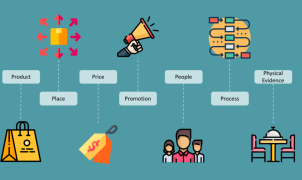Multi-channel marketing, favored by businesses, involves promoting products and services across online and offline platforms. Enhancing visibility to target customers and boosting brand recognition are notable advantages. Let’s delve deeper into this marketing model!
1. What is Multi-Channel Marketing?
Multi-Channel Marketing focuses on reaching customers through various channels, both online and offline. Brands employing this strategy can establish a consistent presence across platforms and reach their target audience effectively.
However, when marketing across multiple channels, presence and strategy must align. It’s essential not to focus on different platforms without coherence and alignment with goals.
Instead, to craft messages for each platform, a consistent strategy is crucial. If targeting the same audience, develop a unified supplementary strategy for approaching them across platforms.
Your potential customers could be anywhere, and your task is to be present everywhere they are. As potential marketing channels expand, implementing Multi-Channel Marketing campaigns will continue to be key to success.

2. The Importance of Multichannel Marketing
Numerous channels exist to reach your target audience, and the number keeps growing. Apart from traditional marketing channels like billboards, direct mail, flyers, and networking events, digital channels like Facebook, Twitter, Instagram, YouTube, LinkedIn, Messenger, TikTok, etc., are equally crucial.
Focusing on a single channel means missing out on many other customer opportunities. Moreover, multi-channel customers spend three to four times more than single-channel customers, justifying the investment in this strategy.
2.1. Increasing Brand Awareness and Recognition
Multi-channel methods create a network of channels to maximize customer reach, resulting in increased brand presence across various platforms.
Customers not only actively receive information on chosen channels but also passively encounter similar information across multiple channels, enhancing their awareness of your brand.
Moreover, Multi-channel marketing allows reaching customers on channels they actively choose without influencing their purchasing decisions.
2.2. Message Consistency
Maintaining message consistency across different channels is a common challenge in marketing campaigns. Each campaign aims to impact customer awareness and behavior, whether targeting potential, new, or existing customers.
Multi-channel marketing not only ensures message alignment but also enables departments to proactively push the message across channels.
2.3. Data Collection
More touchpoints (channels) mean more customer data. However, since the multi-channel approach aims to convey information across as many channels as possible, primary data focuses on the sales channel rather than the customer.
3. Challenges of Implementing Multi-Channel Marketing Strategies
Despite the benefits, Multi-channel marketing poses challenges:
3.1. Marketing and Strategy
Multi-channel Marketing lacks strategic depth. While it involves various media to reach customers, a true multi-channel strategy considers customer journeys and interactions across platforms.
Therefore, rather than just applying Multi-channel marketing, a specific and detailed multi-channel strategy is crucial.
3.2. Increasing Complexity with More Channels
Expanding channels means developing and expanding messages across all of them while collecting additional customer data.
3.3. Time and Resources
Expanding channel networks and management tools require more time and resources. Implementing an effective multi-channel marketing plan demands significant investment.
3.4. Permissions
Implementing multi-channel marketing without a clear strategy can lead to confusion and difficulties in budgeting and resource allocation.
4. Building an Effective Multi-Channel Marketing Model
Implementing multi-channel marketing need not be overly complicated. Here are five simple steps:
4.1. Identify Customer Profiles
Understanding the demographics and behaviors of your target audience is crucial for a successful multi-channel strategy.
4.2. Determine Access Channels
Select channels based on where your target customers are most likely to engage, both online and offline.
4.3. Develop Messages
Craft a unified message adaptable to each channel, ensuring consistency but tailored to platform specifics.
4.4. Integrate Channels
Ensure seamless connectivity of messages across channels, possibly by designating a primary platform for content distribution.
4.5. Define Key Performance Indicators (KPIs)
Establish KPIs for each channel to gauge campaign success and adapt strategies accordingly.
5. Successful Examples of Multi-Channel Marketing
Apple exemplifies successful multi-channel marketing by integrating digital platforms with retail stores, providing customers with an immersive experience and emphasizing service over sales.
In conclusion, Multi-channel marketing is a powerful strategy for businesses to engage customers effectively across various platforms. Understanding its concepts and challenges can help optimize marketing strategies across different channels.
Cre: tanca



















































































































































